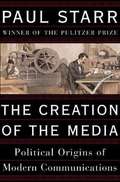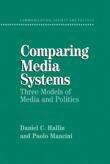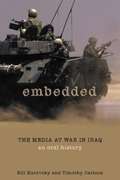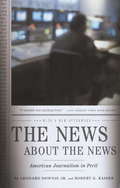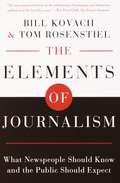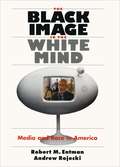Special Collections
Goldsmith Book Prize
Description: The Goldsmith Book Prize is awarded to the trade and academic book published in the last 24 months that best fulfills the objective of improving democratic governance by examining of the intersection between the media, politics and public policy. #award
- Table View
- List View
The Creation of the Media
by Paul StarrAmerica's leading role in today's information revolution may seem simply to reflect its position as the world's dominant economy and most powerful state. But by the early nineteenth century, when the United States was neither a world power nor a primary center of scientific discovery, it was already a leader in communications-in postal service and newspaper publishing, then in development of the telegraph and telephone networks, later in the whole repertoire of mass communications.
In this wide-ranging social history of American media, from the first printing press to the early days of radio, Paul Starr shows that the creation of modern communications was as much the result of political choices as of technological invention. His original historical analysis reveals how the decisions that led to a state-run post office and private monopolies on the telegraph and telephone systems affected a developing society. He illuminates contemporary controversies over freedom of information by exploring such crucial formative issues as freedom of the press, intellectual property, privacy, public access to information, and the shaping of specific technologies and institutions. America's critical choices in these areas, Starr argues, affect the long-run path of development in a society and have had wide social, economic, and even military ramifications. The Creation of the Media not only tells the history of the media in a new way; it puts America and its global influence into a new perspective.
Comparing Media Systems
by Daniel C. Hallin and Paolo ManciniComparing Media Systems Beyond the Western World offers a broad exploration of the conceptual foundations for comparative analysis of media and politics globally. It takes as its point of departure the widely used framework of Daniel C. Hallin and Paolo Mancini's Comparing Media Systems, exploring how the concepts and methods of their analysis do and do not prove useful when applied beyond the original focus of their "most similar systems" design and the West European and North American cases it encompassed. It is intended both to use a wider range of cases to interrogate and clarify the conceptual framework of Comparing Media Systems and to propose new models, concepts, and approaches that will be useful for dealing with non-Western media systems and with processes of political transition. Comparing Media Systems Beyond the Western World covers, among other cases, Brazil, China, Israel, Lebanon, Lithuania, Poland, Russia, Saudi Arabia, South Africa, and Thailand.
Embedded
by Bill Katovsky and Timothy CarlsonEMBEDDED is a collection of deeply emotional and highly personal accounts of covering the Iraq War. Many of the world's top war correspondents and photographers speak candidly about life on the battlefield. Here are articulate and heartfelt descriptions of fear and firefights, of bullets and banalities, of risking death and meeting deadlines.
With over sixty interviews conducted in Kuwait and Iraq shortly after many returned home, Katovsky and Carlson allowed these journalists to step outside their professional role as journalists and examine the lethal allure of combat reporting.
Here is CBS Evening News correspondent Jim Axelrod discussing the perils of racing to Baghdad while despondent over the death of a television colleague and being unexpectedly comforted by ABC News Nightline's Ted Koppel; Newsweek reporter Scott Johnson unwittingly driving into an ambush and then kicking out the windshield of his bullet-riddled car to escape the Iraqi gunmen; New York Times Baghdad Bureau Chief John Burns's brave refusal to be intimidated by his Iraqi information ministry minders; and many, many more.
Each interview in EMBEDDED maps its own personal path and narrative arc, while presenting an emotional window to war and reporting. Taken individually, each offers a unique view of the most-covered war in history. Collectively, EMBEDDED is an eyewitness to history that will do for the war in Iraq what Michael Herr's Dispatches did for Vietnam.
The Mass Media and the Dynamics of American Racial Attitudes
by Paul M. KellstedtPaul M. Kellstedt explains the variation in Americans' racial attitudes over the last half-century, particularly the relationship between media coverage of race and American public opinion on race. The analyses reveal that racial policy preferences have evolved in an interesting and unpredicted (if not unpredictable) fashion over the past fifty years. There have been sustained periods of liberalism, where the public prefers an active government to bring about racial equality, and these periods are invariably followed by eras of conservatism, where the public wants the government to stay out of racial politics altogether. These opinions respond to cues presented in the national media. Kellstedt then examines the relationship between attitudes on the two major issues of the twentieth century: race and the welfare state.
The News About the News
by Leonard Downie Jr. and Robert G. KaiserTwo editors from the argue that, while there is some excellent journalism in the United States, much of it is puerile and uninformative. The nature of good journalism is discussed, with the and other papers held up as examples and local television news being singled out for strong opprobrium.
Separate chapters examine news production at newpapers, network television stations, local stations, and on the Internet.
The Elements of Journalism
by Bill Kovach and Tom RosenstielIn July 1997, twenty-five of America's most influential journalists sat down to try and discover what had happened to their profession in the years between Watergate and Whitewater. What they knew was that the public no longer trusted the press as it once had. They were keenly aware of the pressures that advertisers and new technologies were putting on newsrooms around the country. But, more than anything, they were aware that readers, listeners, and viewers — the people who use the news — were turning away from it in droves.
There were many reasons for the public's growing lack of trust. On television, there were the ads that looked like news shows and programs that presented gossip and press releases as if they were news. There were the "docudramas," television movies that were an uneasy blend of fact and fiction and which purported to show viewers how events had "really" happened. At newspapers and magazines, celebrity was replacing news, newsroom budgets were being slashed, and editors were pushing journalists for more "edge" and "attitude" in place of reporting. And, on the radio, powerful talk personalities led their listeners from sensation to sensation, from fact to fantasy, while deriding traditional journalism. Fact was blending with fiction, news with entertainment, journalism with rumor.
Calling themselves the Committee of Concerned Journalists, the twenty-five determined to find how the news had found itself in this state. Drawn from the committee's years of intensive research, dozens of surveys of readers, listeners, viewers, editors, and journalists, and more than one hundred intensive interviews with journalists and editors, The Elements of Journalism is the first book ever to spell out — both for those who create and those who consume the news — the principles and responsibilities of journalism. Written by Bill Kovach and Tom Rosenstiel, two of the nation's preeminent press critics, this is one of the most provocative books about the role of information in society in more than a generation and one of the most important ever written about news. By offering in turn each of the principles that should govern reporting, Kovach and Rosenstiel show how some of the most common conceptions about the press, such as neutrality, fairness, and balance, are actually modern misconceptions. They also spell out how the news should be gathered, written, and reported even as they demonstrate why the First Amendment is on the brink of becoming a commercial right rather than something any American citizen can enjoy.
The Elements of Journalism is already igniting a national dialogue on issues vital to us all. This book will be the starting point for discussions by journalists and members of the public about the nature of journalism and the access that we all enjoy to information for years to come.
The Black Image in the White Mind
by Andrew Rojecki and Robert M. EntmanLiving in a segregated society, white Americans learn about African Americans not through personal relationships but through the images the media show them. The Black Image in the White Mind offers the most comprehensive look at the intricate racial patterns in the mass media and how they shape the ambivalent attitudes of Whites toward Blacks. Using the media, and especially television, as barometers of race relations, Robert Entman and Andrew Rojecki explore but then go beyond the treatment of African Americans on network and local news to incisively uncover the messages sent about race by the entertainment industry-from prime-time dramas and sitcoms to commercials and Hollywood movies. While the authors find very little in the media that intentionally promotes racism, they find even less that advances racial harmony. They reveal instead a subtle pattern of images that, while making room for Blacks, implies a racial hierarchy with Whites on top and promotes a sense of difference and conflict. Commercials, for example, feature plenty of Black characters. But unlike Whites, they rarely speak to or touch one another. In prime time, the few Blacks who escape sitcom buffoonery rarely enjoy informal, friendly contact with White colleagues—perhaps reinforcing social distance in real life. Entman and Rojecki interweave such astute observations with candid interviews of White Americans that make clear how these images of racial difference insinuate themselves into Whites' thinking. Despite its disturbing readings of television and film, the book's cogent analyses and proposed policy guidelines offer hope that America's powerful mediated racial separation can be successfully bridged. "Entman and Rojecki look at how television news focuses on black poverty and crime out of proportion to the material reality of black lives, how black 'experts' are only interviewed for 'black-themed' issues and how 'black politics' are distorted in the news, and conclude that, while there are more images of African-Americans on television now than there were years ago, these images often don't reflect a commitment to 'racial comity' or community-building between the races. Thoroughly researched and convincingly argued."—Publishers Weekly "Drawing on their own research and that of a wide array of other scholars, Entman and Rojecki present a great deal of provocative data showing a general tendency to devalue blacks or force them into stock categories."—Ben Yagoda, New Leader Winner of the Frank Luther Mott Award for best book in Mass Communication and the Robert E. Lane Award for best book in political psychology.
